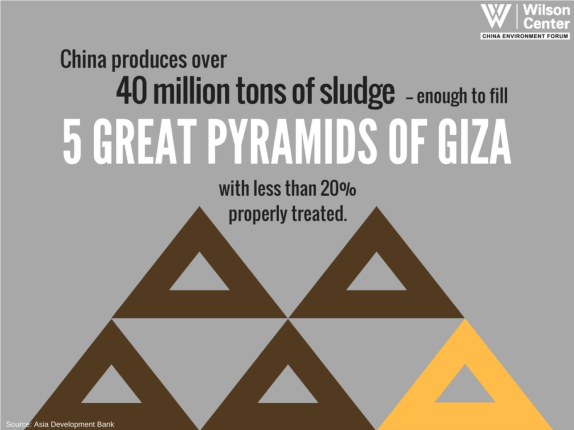-
Tapping the Power in China’s Municipal Sludge

In September 2018, the Jinghu District People’s Court in Wuhu, Anhui Province sentenced 12 people from the Pol Shin Fastener Company between four months and six years in prison for committing serious interprovincial environmental crimes in Jiangsu and Anhui in 2016 and 2017. The court also fined the automobile hardware manufacturer 10 million yuan ($1.48 million). The crime? Dispatching ships and trucks to illegally dump 2500+ metric tons of highly acidic pickling sludge from steel production. Sludge—semi-solid waste emissions from industries and municipal water treatment plants—is yet another tough water and solid waste pollution challenge China faces.
Industries are not the only source of China’s growing sludge problem, Chinese cities produce enough sludge from wastewater treatment plants to fill more than five pyramids of Giza annually. However, only one of these “sludge pyramids” is properly treated. Cities send the rest of the nation’s sludge to landfills, incinerators, or dump it illegally.
Empowered by the 2015 Water Pollution Prevention and Control Action Plan and the 13th Five Year Plan on Urban Wastewater Treatment, China’s Ministry of Ecological Environment is cracking down on sludge pollution to enforce specific sludge and wastewater standards. In June 2018, inspectors found Taixing City Binjiang Wastewater Treatment Co., Ltd. had illegally stored and dumped nearly 40,000 tons of sludge that contaminated water and soil in the Yangtze River Delta.
The Binjiang wastewater plant was operating overcapacity, processing 60,000 tons of domestic sewage and 20,000 tons of industrial wastewater every day. As a result, it was unable to properly dispose of the approximately 17 tons of sludge it produces every day. According to one Chinese media source Sohu, the plant, local government cadres, and the deputy secretary of the Taixing Municipal Party Working Committee received nominal punishments. Even so, Sohu reported in January 2019 that little change was noticeable in the amount of sludge being improperly stored and disposed in Taixing, underscoring the critical gaps that remain in China’s sludge and water pollution regime.
To understand the drivers and possible solutions to China’s municipal sludge pollution, the China Environment Forum took a deep dive into wastewater treatment in the new report, Scaling Sludge Mountains: Breaking Down Barriers for Chinese Cities to Turn Sludge Waste into Energy (full publication below), which was written with support from the U.S. EPA and the Global Methane Initiative.
Scaling Sludge Mountains: B… by on Scribd
While China’s rapid expansion of wastewater treatment plants in the early 2000s was a step toward improved water quality, the report discusses how cities were not incentivized to develop efficient sludge treatment practices to capture methane to turn it into electricity or natural gas. In addition to explaining the benefits of sludge-to-energy (S2E), the report describes opportunities for Chinese cities to remove the barriers to S2E.
Capturing the Power of Sludge
Sludge is often rich in organic matter— a key characteristic and double-edged sword when it comes to disposal. When improperly treated, illegally dumped, or landfilled, the organic material in sludge decomposes, produces and releases methane, a short-lived climate pollutant. While methane stays in the atmosphere for a shorter period than CO2, it has a greater climate warming impact.
However, if treated via anaerobic digestion (AD) in a closed reactor, the methane can be collected, cleaned of hydrogen sulfide and carbon dioxide, and reused on site as a source of electricity or turned into natural gas and sold as vehicle biofuel. AD yields another profitable byproduct: digestate, a nutrient-rich substance that can be sold as fertilizer.
The China Environment Forum’s Scaling Sludge Mountains reports that 50 municipal sludge anaerobic digestion facilities exist in China, with many unable to optimize the benefits of S2E due to stormwater runoff that has diluted the wastewater and sludge. The result is low organic content, which limits the real moneymaker of AD production: the amount of methane biogas produced. To maximize the amount of organic material in their sludge, Chinese wastewater facilities can look to incorporate food waste streams, which is exactly what one trail-blazing plant in Hubei Province decided to do.
TOVEN operates the Yuliangzhou Sludge-to-Energy Plant in Xiangyang City (Hubei), which was the first to introduce high-temperature thermal hydrolysis, highly concentrated AD, and methane capture and utilization technology. But without sufficient organic material, even this cutting-edge technology would not produce methane. That changed when the Xiangyang government mandated all 5,000 restaurants in the city send their food waste to the sludge plant. The addition of food waste enabled the plant to process mountains of sludge that had accumulated for years and make a profit via co-digestion. The Xiangyang plant managers have capitalized on the byproducts of AD by selling compressed natural gas (CNG) to local taxi companies and marketing biochar (charcoal) as a soil amendment to tree growers and container forests for urban parks and gardens.
Stumbling Blocks for Poop to Power
For wastewater treatment plants in China to reap the benefits of sludge-to energy and create low carbon water, they must overcome several systemic obstacles to efficient and eco-friendly management practices. Scaling Sludge Mountains Report highlights new insights into China’s sludge management regime, identifying several stumbling blocks to S2E implementation.
Inadequate Data Collection. In 2015, the Ministry of Housing and Urban-Rural Development (MoHURD) estimated that approximately 10 percent of the country’s sludge could not be accounted for at all. Regulators cannot manage what is not being monitored, so bridging the data gap will be vital.
Missed Targets. In China, over 80 percent of sludge receives dewatering treatment to lower the overall amount. About 75 percent of this dewatered sludge does not undergo any further treatment and is either landfilled, incinerated, or illegally dumped. Many cities have failed to meet the sludge treatment targets stipulated in the 13th Five-Year Plan (FYP). In 2015, Beijing was treating and safely disposing of only 23 percent of the 1.02 million tons of sludge it produced that year. Only 11 percent of China’s villages had any sort of access to wastewater treatment facilities. The same year, the MoHURD announced that only 56 percent of China’s municipal sludge was being disposed of safely. However, new plants are being built with the target of treating 100 percent of sludge in the next few years.
Lack of Food Waste Supply. Few facilities have matched Xiangyang’s steady food waste supply to enhance methane production. As it stands, the country has yet to institutionalize a sustainable system of utilizing its food waste. However, with Xi Jinping’s new mandate for cities to accelerate municipal waste sorting, wastewater plants with AD may be able to tap at least some of the nearly 60 percent of local city waste that is food waste.
Financing Concerns. Wastewater plants in New York, Los Angeles, and Boston are using captured methane to power their plants and have succeeded in markedly lower energy costs and lowering costs to consumers. Chinese banks also need guidance to understand the financial and environmental win-win of S2E, so they will be more inclined to invest in such infrastructure.
Policy gaps. Like plants in New York and Oakland, California, sludge-to-energy plants in China could become another form of distributed power, feeding excess electricity into local grids. China’s policies encouraging solar power expansion domestically has increased rooftop and other forms of distributed solar and perhaps this could open doors for waste methane to also supply local grids. The number of CNG taxis and busses has been on the rise in China over the past 20 years, but with the government’s push for electric vehicles, it is unclear if the market for biofuel from methane gas will become a party priority in the years to come.
China is on its way to scale the sludge mountain. Converting municipal sludge to biogas and fertilizer is one option that shows promise while supporting China’s green energy goals. Linking together sludge and food waste management is a way to fully utilize both waste streams.
Gillian Zwicker is a research assistant at the Wilson Center’s China Environment Forum in Washington, D.C. She received her MA in International Studies and Energy, Resources and the Environment from the Hopkins – Nanjing Center in 2018.
Jennifer L. Turner is the Program Director of the China Environment Forum at the Woodrow Wilson Center in Washington, D.C. She is also the manager of the Wilson Center and Circle of Blue’s Global Choke Point Initiativeennifer L. Turner is the Program Director of the China Environment Forum at the Woodrow Wilson Center in Washington, D.C. She is also the manager of the Wilson Center and Circle of Blue’s Global Choke Point Initiative.
Sources: Anaerobic Digestion, China Daily, China Environment Forum, JQKnews, National Development and Reform Commission, Phys.org, Reuters, Scientific American, Sohu.com, State Council of the People’s Republic of China, United States Environmental Protection Agency, Waste 360, Water & Wastewater International, World Resources Institute, Zhaopin.com.
Topics: China, China Environment Forum, development, energy, environment, Infrastructure, meta, natural gas, sanitation, water
 A Publication of the Stimson Center.
A Publication of the Stimson Center.







